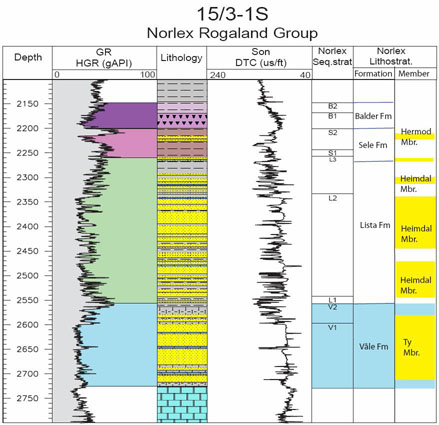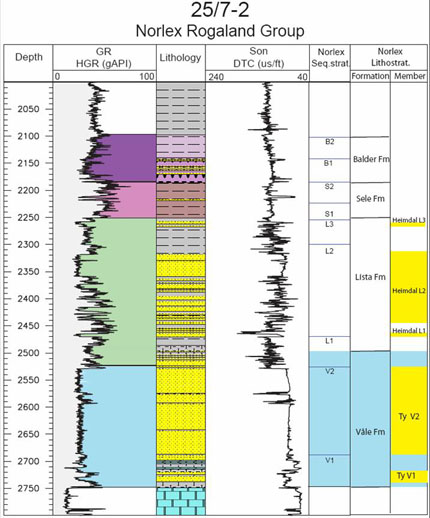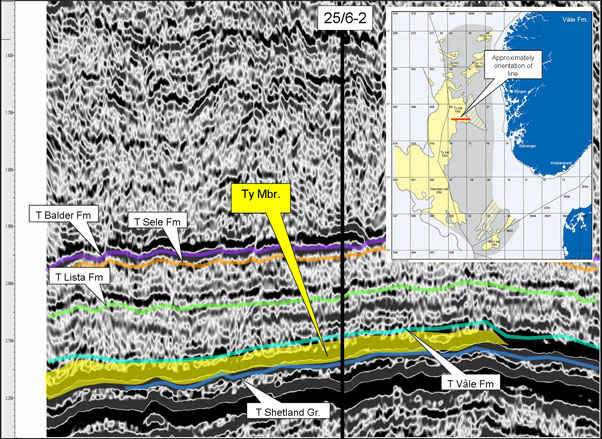Ty Member
updated to follow: Stratigraphic Guide to the Rogaland Group, Norwegian North Sea. Harald Brunstad, Felix M. Gradstein, Jan Erik Lie, Øyvind Hammer, Dirk Munsterman, Gabi Ogg, and Michelle Hollerbach. Newsletter on Stratigraphy, vol 46/2 pp137-286, 2013.
Rogaland Group, Våle Formation
Unit definition
The Ty Member is attributed to the intra Våle Formation sandstones in subarea NW in Figs.
12, 13 and 42.
Name
The Ty Formation (now Ty Member) was defined by Hardt et al., in Isaksen and Tonstad (1989).
Derivatio nominis
The Ty Member is named after Ty, a son of the Norse god Odin, and he was one of the twelve
principal gods in Norse Mythology.
Type well
UK well 10/1-1A. Depth 2767 to 2421 m. Coordinates N 59°50'10.50", E 02°00'33.60". No
cores. Defined by Hardt et al., 1989.
Reference wells
Norwegian well 15/3-1 S, (Fig.
52). Depth 2715 to 2556m, Coordinates N 58°50'57.00", E 01°43'13.25". No cores. Defined by
Hardt et al., 1989.
Norwegian Well 25/7-2 (new, Fig.
53). Depth 2529-2698 m, Coordinates N 59°16'28.59", E 02°12'26.09". No cores.

Fig. 52. Well 15/3-1 S composite log Rogaland Group. Stratigraphic position of the Ty Member
is outlined in stratigraphic column to the right.
|

Fig. 53. Well 25/7-2 composite log Rogaland Group. Stratigraphic position of the Ty Member
is outlined in stratigraphic column to the right.
|
Composition
The Ty Member generally consists of massive, clean sandstones of varying grain size. Although
the Ty sandstones are mostly quartzitic, they can contain glauconite. The sandstones of the
Ty Member, especially Ty V1, are often interbedded with zones of reworked chalk material and
flint clasts. The sandstones are often carbonate cemented, especially when sand layer
thickness is limited. The colour is clear to light grey (Hardt et al., 1989). The Ty
Member is well covered by cores in the Sleipner East and Balder/Grane areas and in well
26/4-1. Most of the sandstones are
rather thick, clean, massive and structureless, but silty
sandstones are also observed. Occasionally, ripple cross lamination can be found.
Wireline log characterization
On wire line logs, sandstones of the Ty Member generally have a blocky appearance. Sandstones
in the Ty V2 (upper Ty Member) are generally thicker and sonic logs suggest that
they are generally less cemented than the lower Ty V1 Member.
Lower boundary
The Ty Member rests on the Våle Formation or directly on the
Shetland Group. There is a
distinct upwards change from low-gamma-ray readings and high velocities in the calcareous
sediments of the Shetland Group or the Våle Formation to higher gamma-ray readings and lower
velocities in the Ty Member.
Upper boundary
The upper boundary is characterised by a downwards transition from higher gamma-ray readings
and lower velocity in the Våle or Lista
Formation to lower gamma-ray readings and higher velocity in the Ty Member.
Thickness
The thickness of the Ty Member is 346 m in type well UK 10/1-1A. In reference well 15/3-1 it
is 159 m, and in type well 25/7-2 it is close to 200 m. A thickness of 170 m is attained in
well 25/5-1, 250 m in 25/3-1.
Seismic characterization
The Ty Member mostly consists of laterally stacked seismic bodies of lenticular to mounded
character. Continuity and character and amplitude of internal seismic reflectors vary
considerably, and are generally only mappable in local areas. Fig. 54 shows an example of
seismic character associated with Ty sandstones in the southeastern parts of block 25/6.

Fig. 54. Seismic WE section through well 25/6-2, highlighting the interval with Ty Member
Present.
|
Age
Lower to Middle Paleocene (Danian-Early Selandian).
Biostratigraphy
Being contained in the Våle Formation, the age of the Ty Member is bounded by biostratigraphy
and age assignments for the Våle Formation. See description for the Våle
Formation in Subchapter 4.1.
Correlation and subdivision
The Ty Member is divided into Ty V1 Sub-member (Lower Ty Member) and Ty V2 Sub-member (Upper
Ty Member).
Geographic distribution
The Ty Member is represented by an interval of areally extensive sandstones in the Våle
Formation interval of the Viking Graben. The Ty Member has its eastern limit against the
Utsira High. The southern limit is the west-east Member separation line from Fladen Ground Spur
to the southern tip of the Utsira High (Figs. 12 and 13). In the north the Ty sandstones
reach their eastern limit before the Norwegian boundary (Fig. 48).
Depositional environment
In the Norwegian sector the Ty Member was deposited from gravitational flows in a deep marine
slope to basinal setting. The sandstones have the East Shetland Platform as their provenance
and probably have multiple sources. Sandstones appear to have been deposited from
gravitational flows in the form of turbidity currents and possibly grain flow and may in
general be classified as sand rich systems.
Hydrocarbon discoveries in the Ty Member
- Sleipner East
- Norwegian 16/7-2 gas and condensate discovery




